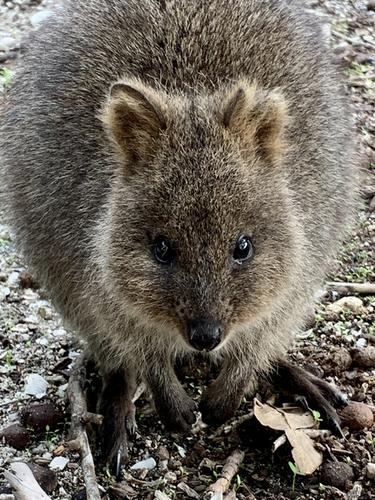Our official English website, www.x-mol.net, welcomes your
feedback! (Note: you will need to create a separate account there.)
Invasive species, not environmental changes, restrict the population and geographical range of the quokka (Setonix brachyurus)
Journal of Zoology ( IF 1.9 ) Pub Date : 2020-02-21 , DOI: 10.1111/jzo.12765 E. J. Scholtz 1 , L. R. G. DeSantis 1, 2
Journal of Zoology ( IF 1.9 ) Pub Date : 2020-02-21 , DOI: 10.1111/jzo.12765 E. J. Scholtz 1 , L. R. G. DeSantis 1, 2
Affiliation

|
European arrival into Australia had large‐scale impacts on the local flora and fauna. Most notably, Europeans brought with them numerous non‐native species, including the European red fox (Vulpes vulpes), European rabbit (Oryctolagus cuniculus), and the goat (Capra hircus) among many others. The introduction of these species had significant consequences on native Australian mammals, causing some small‐ to medium‐sized herbivores to become geographically restricted to primarily islands. Here, we examined the dietary ecology of the quokka (Setonix brachyurus), a native marsupial herbivore with a restricted geographic range in Western Australia before and after European arrival. Fossils from south‐western Australia and modern specimens were examined via dental microwear texture analysis and stable isotope analysis to assess whether the diet of the quokka had changed dramatically over time. Collectively, we help clarify whether there were any ecological reasons as to why this marsupial became geographically restricted, aside from the presence of invasive predators on mainland Australia. The quokka maintains a browsing diet from the Pleistocene to the present on the mainland, but modern island populations eat drier and tougher foods when living on islands lacking invasive mammals. There is also an apparent shift in the feeding environment of the quokkas on mainland Australia, from more open forests/shrublands in the Pleistocene to denser and wetter forests. Multi‐proxy data collectively indicate that the restricted range of the quokka today is most likely a result of predation from non‐native taxa and/or other human influences—not because of a lack of suitable habitat.
中文翻译:

外来入侵物种而非环境变化限制了短尾((Setonix brachyurus)的种群和地理范围
欧洲人抵达澳大利亚对当地动植物产生了大规模影响。最值得注意的是,欧洲人带来了许多非本地物种,包括欧洲红狐狸(Vulpes vulpes),欧洲兔子(Oyctolagus cuniculus)和山羊(Capra hircus)等。这些物种的引进对澳大利亚本土哺乳动物产生了重大影响,导致一些中小型草食动物在地理上主要局限于岛屿。在这里,我们研究了短尾the(Setonix brachyurus),这是欧洲到来之前和之后在西澳大利亚州地理范围有限的原生有袋食草动物。通过牙科微磨质地分析和稳定同位素分析,对来自澳大利亚西南部的化石和现代标本进行了检查,以评估水quo的饮食是否随时间发生了显着变化。总的来说,除了澳大利亚大陆上存在入侵性掠食者外,我们还帮助弄清这种有袋动物为何在地理上受到限制是否有任何生态学原因。从大陆到近更新世,美洲狮一直保持着饮食习惯,但是当现代岛上的居民生活在缺乏侵入性哺乳动物的岛上时,他们的饮食就比较干燥,食物更坚硬。澳大利亚大陆上的美洲狮的摄食环境也发生了明显变化,从更新世的更开放的森林/灌木丛到更茂密的森林。多种代理数据共同表明,今天的短尾羚羊的活动范围有限,很可能是非本地分类群和/或其他人为因素的掠夺的结果,而不是因为缺少合适的栖息地。
更新日期:2020-02-21
中文翻译:

外来入侵物种而非环境变化限制了短尾((Setonix brachyurus)的种群和地理范围
欧洲人抵达澳大利亚对当地动植物产生了大规模影响。最值得注意的是,欧洲人带来了许多非本地物种,包括欧洲红狐狸(Vulpes vulpes),欧洲兔子(Oyctolagus cuniculus)和山羊(Capra hircus)等。这些物种的引进对澳大利亚本土哺乳动物产生了重大影响,导致一些中小型草食动物在地理上主要局限于岛屿。在这里,我们研究了短尾the(Setonix brachyurus),这是欧洲到来之前和之后在西澳大利亚州地理范围有限的原生有袋食草动物。通过牙科微磨质地分析和稳定同位素分析,对来自澳大利亚西南部的化石和现代标本进行了检查,以评估水quo的饮食是否随时间发生了显着变化。总的来说,除了澳大利亚大陆上存在入侵性掠食者外,我们还帮助弄清这种有袋动物为何在地理上受到限制是否有任何生态学原因。从大陆到近更新世,美洲狮一直保持着饮食习惯,但是当现代岛上的居民生活在缺乏侵入性哺乳动物的岛上时,他们的饮食就比较干燥,食物更坚硬。澳大利亚大陆上的美洲狮的摄食环境也发生了明显变化,从更新世的更开放的森林/灌木丛到更茂密的森林。多种代理数据共同表明,今天的短尾羚羊的活动范围有限,很可能是非本地分类群和/或其他人为因素的掠夺的结果,而不是因为缺少合适的栖息地。











































 京公网安备 11010802027423号
京公网安备 11010802027423号